In the bitter winter of 1777-1778, as the Continental Army endured harsh conditions at Valley Forge Pennsylvania, a flag was raised above General George Washington’s headquarters: thirteen 6-point white stars on a distinctive blue background. This flag, known as the Washington Headquarters Flag or Commander-in-Chief Flag, became a powerful symbol of American perseverance and leadership during the Revolutionary War.
Origins of the Commander-in-Chief Flag
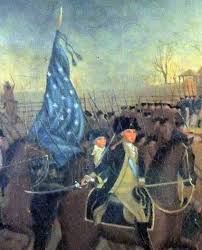
The Washington Headquarters Flag represented one of the earliest designs incorporating stars as a symbol of the American colonies. While its exact origins remain somewhat mysterious, historical evidence suggests it was likely created in 1777, around the same time that Congress adopted the first official American flag design. The flag featured 13 white six-pointed stars arranged in a 3-2-3-2-3 pattern on a blue field – no red-and-white stripes yet.
The flag gained its greatest significance during the Continental Army’s winter encampment at Valley Forge. From December 1777 to June 1778, Washington led approximately 12,000 troops through what would become one of the most pivotal periods of the Revolutionary War. Though no major battles were fought here, Valley Forge proved to be the turning point that transformed a struggling colonial militia into a professional fighting force.
The challenges at Valley Forge were staggering. Of the 12,000 troops, about 2,000 died from disease, malnutrition, and exposure to the harsh winter conditions. Soldiers endured severe shortages of food, with many days passing on nothing but “firecake” – a tasteless mixture of flour and water. Clothing was so scarce that many men marched through snow leaving bloody footprints from their worn-out boots or bare feet. Meanwhile, the Continental Congress struggled to provide supplies, highlighting the young nation’s administrative challenges.
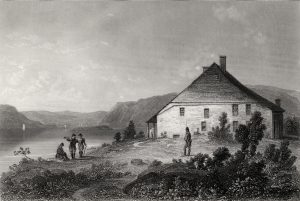
However, it was these very hardships that forged the American Army into a more cohesive and capable fighting force. Baron Friedrich von Steuben, a Prussian military officer, arrived at Valley Forge in February 1778 and implemented a rigorous training program. He standardized military drills, weapons training, and camp sanitation practices. Most importantly, he created a unified system of military discipline and tactics that all soldiers could follow, regardless of which colony they came from.
The transformation was remarkable. By spring, the army had evolved from a collection of disparate colonial militias into a unified professional force capable of standing against British regulars. This newfound discipline and unity would prove crucial in future battles, particularly at Monmouth Courthouse in June 1778, where the reformed Continental Army held its own against the British in one of the war’s largest battles.
Washington’s Revolutionary Leadership
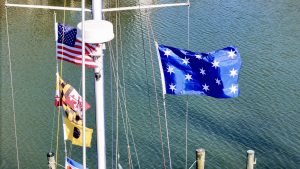
During this transformative period, the Washington Headquarters Flag served as both a practical marker of the command post and a powerful symbol of perseverance. Soldiers enduring the brutal conditions could look up and see the distinctive pattern of stars against the blue field, a reminder of the thirteen colonies united in their struggle for independence. The flag became emblematic of Washington’s steady leadership through adversity and the army’s determination to emerge stronger despite overwhelming challenges.
General Washington’s role during the Revolutionary War extended far beyond traditional military leadership. As Commander-in-Chief, he faced the monumental task of forging a professional army from a collection of colonial militias. His leadership style, marked by steadfast determination and personal example, proved crucial to the American cause.
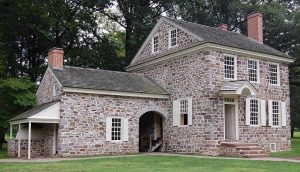
At Valley Forge, Washington demonstrated these qualities daily. He shared the hardships of his men, refusing comfortable quarters in favor of staying in conditions similar to his troops. Under his guidance, the army underwent intensive training led by Baron von Steuben, emerging in the spring as a more capable and professional fighting force.
The Flag’s Legacy
The Washington Headquarters Flag represented more than just military command—it symbolized the emerging nation’s resilience and unity. Today, the original flag is preserved at Valley Forge National Historical Park, where it continues to tell the story of American perseverance during one of the Revolution’s darkest hours.
The flag’s design influenced many subsequent American military flags and standards. Its simple yet powerful arrangement of stars on a blue field became a template for various command flags used throughout American military history.
Impact on American Identity

The winter at Valley Forge, with the Headquarters Flag flying above Washington’s command post, became a defining moment in American history. It demonstrated that the Continental Army, and by extension the American cause, could survive seemingly insurmountable challenges through determination and leadership.
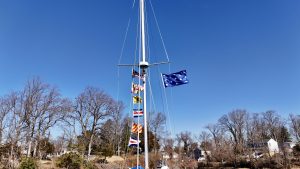
Washington’s role during this period cemented his position as not just a military commander but as a symbol of American leadership and resolve. The flag that flew above his headquarters became intrinsically linked with these qualities, representing both the authority of command and the unity of purpose that would eventually lead to American independence.
Conclusion
The Washington Headquarters Flag stands as a powerful reminder of leadership during crisis, the importance of perseverance, and the birth of American military tradition. Its presence at Valley Forge, flying above Washington’s headquarters during that crucial winter, marks it as more than just a military standard—it represents a pivotal moment when American resolve was tested and prevailed. The flag continues to inspire, reminding us of the sacrifices made during the nation’s founding and the enduring importance of strong, principled leadership in times of adversity.
